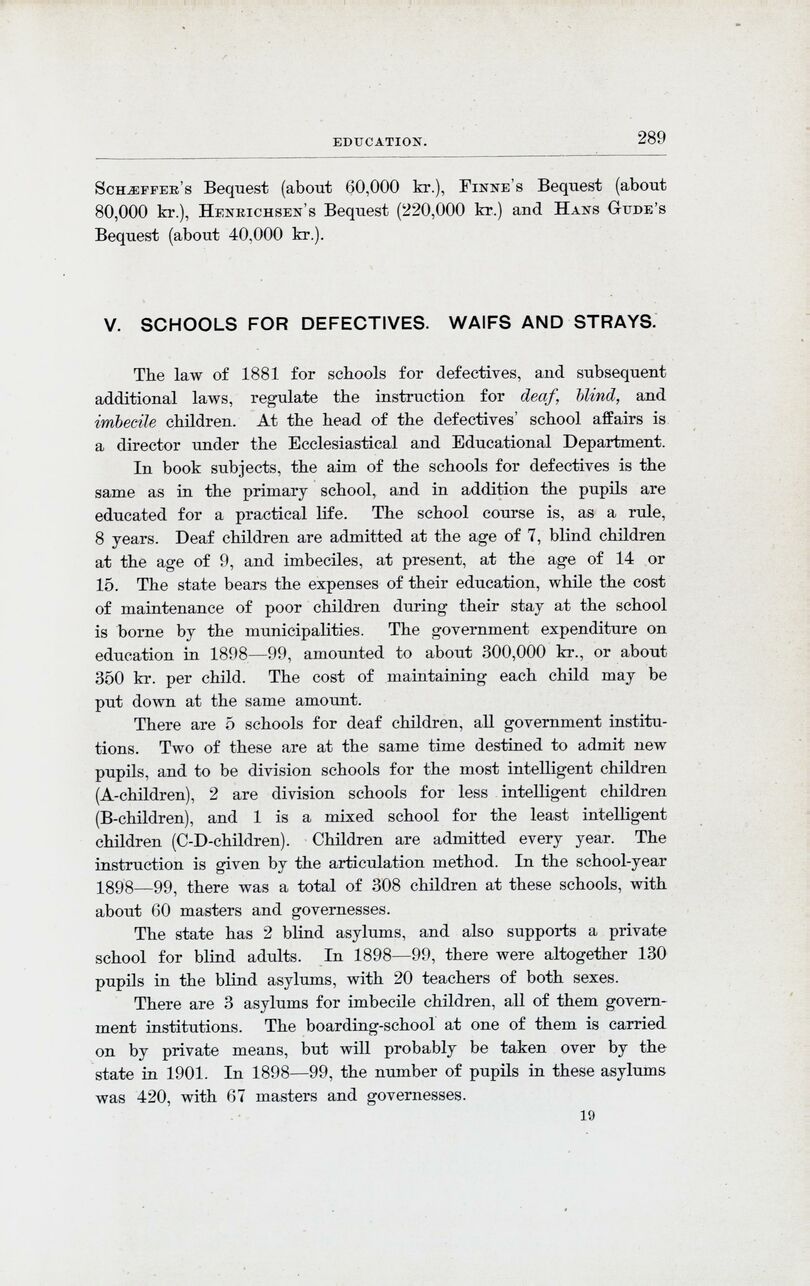
Full resolution (JPEG)
- On this page / på denna sida
- Education, by J. V. Heiberg

<< prev. page << föreg. sida << >> nästa sida >> next page >>
Below is the raw OCR text
from the above scanned image.
Do you see an error? Proofread the page now!
Här nedan syns maskintolkade texten från faksimilbilden ovan.
Ser du något fel? Korrekturläs sidan nu!
This page has been proofread at least once.
(diff)
(history)
Denna sida har korrekturlästs minst en gång.
(skillnad)
(historik)
Schæffer’s Bequest (about 60,000 kr.), Finne’s Bequest (about
80,000 kr.), Henrichsen’s Bequest (220,000 kr.) and Hans Gude’s
Bequest (about 40.000 kr.).
V. SCHOOLS FOR DEFECTIVES. WAIFS AND STRAYS.
The law of 1881 for schools for defectives, and subsequent
additional laws, regulate the instruction for deaf, blind, and
imbecile children. At the head of the defectives’ school affairs is
a director under the Ecclesiastical and Educational Department.
In book subjects, the aim of the schools for defectives is the
same as in the primary school, and in addition the pupils are
educated for a practical life. The school course is, as a rule,
8 years. Deaf children are admitted at the age of 7, blind children
at the age of 9, and imbeciles, at present, at the age of 14 or
15. The state bears the expenses of their education, while the cost
of maintenance of poor children during their stay at the school
is borne by the municipalities. The government expenditure on
education in 1898—99, amounted to about 300,000 kr., or about
350 kr. per child. The cost of maintaining each child may be
put down at the same amount.
There are 5 schools for deaf children, all government
institutions. Two of these are at the same time destined to admit new
pupils, and to be division schools for the most intelligent children
(A-children), 2 are division schools for less intelligent children
(B-children), and 1 is a mixed school for the least intelligent
children (C-D-children). Children are admitted every year. The
instruction is given by the articulation method. In the school-year
1898—99, there was a total of 308 children at these schools, with
about 60 masters and governesses.
The state has 2 blind asylums, and also supports a private
school for blind adults. In 1898—99, there were altogether 130
pupils in the blind asylums, with 20 teachers of both sexes.
There are 3 asylums for imbecile children, all of them
government institutions. The boarding-school at one of them is carried
on by private means, but will probably be taken over by the
state in 1901. In 1898—99, the number of pupils in these asylums
was 420, with 67 masters and governesses.
<< prev. page << föreg. sida << >> nästa sida >> next page >>
Project Runeberg, Sun Dec 10 21:09:24 2023
(aronsson)
(diff)
(history)
(download)
<< Previous
Next >>
https://runeberg.org/norparis/0301.html



